Let me guess: you’ve likely heard that links (or backlinks) are what help your website rank higher in Google. Which means you need to learn how to build them. This, in turn, means you need to know the best link-building tools.
You can think of links as votes. When other websites are linking to your page, it tells Google that your page is somehow important. Which is essentially Google’s PageRank algorithm in a nutshell. Hence, the more high-quality backlinks a page has, the higher it tends to rank in Google.
And if you want to outrank it with your own page, you’ll likely need to get more links than it has.
That’s obviously an oversimplified version, because ranking #1 on Google requires more than just getting more links, as that’s not the only ranking signal that Google utilizes. Nevertheless, it is a very strong signal, and it directly influences your search rankings.
So what are link-building tools, and how do you use them?
Key Takeaways
- Link building is an SEO tactic that involves getting other websites to link to your website.
- It allows search engines like Google may view it as more authoritative and rank it higher in unpaid search results.
- Authority, link placement and relevance are some of the factors that affect a backlink’s value.
- Google, Semrush, Ahrefs and Hunter.io are a few of the best link-building tools you can use for your SEO strategy.
- You can build links by either asking for links, buying them or earning them.
- Link-building tools help simplify the entire process and monitor your progress with detailed results.
What Is Link-Building in SEO?
Link building is an SEO tactic that involves getting other websites to link to your website. So search engines like Google may view it as more authoritative and rank it higher in unpaid search results.
Basically, Google treats certain kinds of links from other sites (backlinks) like endorsements. The higher the quality and quantity of backlinks pointing to your site, the more trustworthy it can seem.
For example, Semrush’s Backlink Analytics tool shows that bbc.co.uk has backlinks from over 1 million domains. These include reputable sites like cdc.gov, microsoft.com, and britannica.com.

Google’s search algorithm takes this strong backlink profile into account when determining whether and how high to include bbc.co.uk in relevant search results. It’s likely to rank the site well as a result. Of course, there are lots of other ranking factors that Google considers, but 8 of the top 20 relate to backlinks, according to our study.
While it’s possible to acquire backlinks naturally over time, proactively building links can help you gain or maintain a competitive edge in search.
What Affects a Backlink’s Value?
Some backlinks are more valuable for your SEO than others. Some don’t have any effect at all. And ones acquired using spammy practices (sometimes known as toxic backlinks) can be harmful.
Here are the main factors to consider when backlink building:
Generally, the more authoritative the referring (linking) site, the more valuable the backlink.
For example, a backlink from bbc.co.uk will likely have a much bigger impact on your SEO than one from an unknown blogger.
Semrush measures site authoritativeness with a metric called Authority Score—which is on a scale out of 100. It considers three main factors:
- Link power: The quality and quantity of backlinks to the site
- Organic traffic: The estimated number of unpaid search engine visits the site gets each month
- Natural profile: How natural (i.e., not spammy) the site’s backlink profile appears to be
If you use a link-building tool to find sites that might link to you when asked, you can review their Authority Scores in the “AS” column.
#2. Relevance
It’s usually better to build SEO links from sites that are highly related to your own, because it suggests you’re well-respected by experts in the field. It’s also better if a backlink appears within highly relevant content.
Let’s say you have three backlinks to your basketball shoes range:
- Backlink 1 appears on a gardening website in an article about growing plants. It’s unlikely to carry much SEO weight (if any) because the site and topic are so unrelated to you.
- Backlink 2 appears on a sports blog in a post about cardiovascular exercise. This could carry some SEO weight because the site shares your niche.
- Backlink 3 appears on a sports blog in a basketball shoe-buying guide. This could carry a good amount of SEO weight, because it suggests your page is highly relevant to the topic at hand. And that the link is genuinely useful to readers.
#3. Link Placement
The more prominent the backlink is on the page, the more valuable it can be for SEO. This is because Google may consider the likelihood that a reader will click on a link based on its location. This is called the “reasonable surfer model”.
For example, links that are in sidebars, in footers, and low on a page’s content may not be worth as much as those higher in the page’s body.
Generally, it’s best if your backlink appears early on in the main body content.
#4. Nofollow, Sponsored, and UGC Attributes
Some links contain a nofollow attribute (or another attribute) that tells Google not to pass ranking strength to the linked page.
Here’s a quick overview of those attributes:
| Link Attribute | Description |
| rel=”nofollow” | Used to identify links that the publisher doesn’t want to endorse. Google is likely to respect the publisher’s wishes. |
| rel=”sponsored” | Used to identify links that were paid for by the linked site. Google ignores these links because they aren’t genuine endorsements. |
| rel=”ugc” | Used to identify links that were placed by users (e.g., in comments sections). Google ignores them because they’re too easy to manipulate. |
While they may drive brand awareness and referral traffic, these kinds of backlinks are unlikely to help your rankings.
Standard links that don’t contain a nofollow, sponsored, or UGC attribute are sometimes called follow links or dofollow links. These are the ones you want when building links for SEO.
#5. Anchor Text
Backlinks with descriptive anchor text (the clickable, linked text) can be better for SEO.
That’s because search engines use anchor text to better understand what the linked page is about. And by extension:
- How the linked page relates to the referring page
- What kinds of keywords (search terms) the linked page should possibly rank for

For example, a backlink with the anchor text “basketball shoes” clearly indicates what the linked page is about. Whereas generic anchor text like “click here” gives no useful context.
That said, it’s important that anchor text reads naturally. If you focus too much on optimizing anchor text for search engines—not users—Google may consider your site to be engaging in spammy link-building practices.
This can lead to a Google penalty that harms your search performance.
Best Link-Building Tools: How to Build Links
Conceptually, most popular link-building strategies fall into one of the following four buckets:
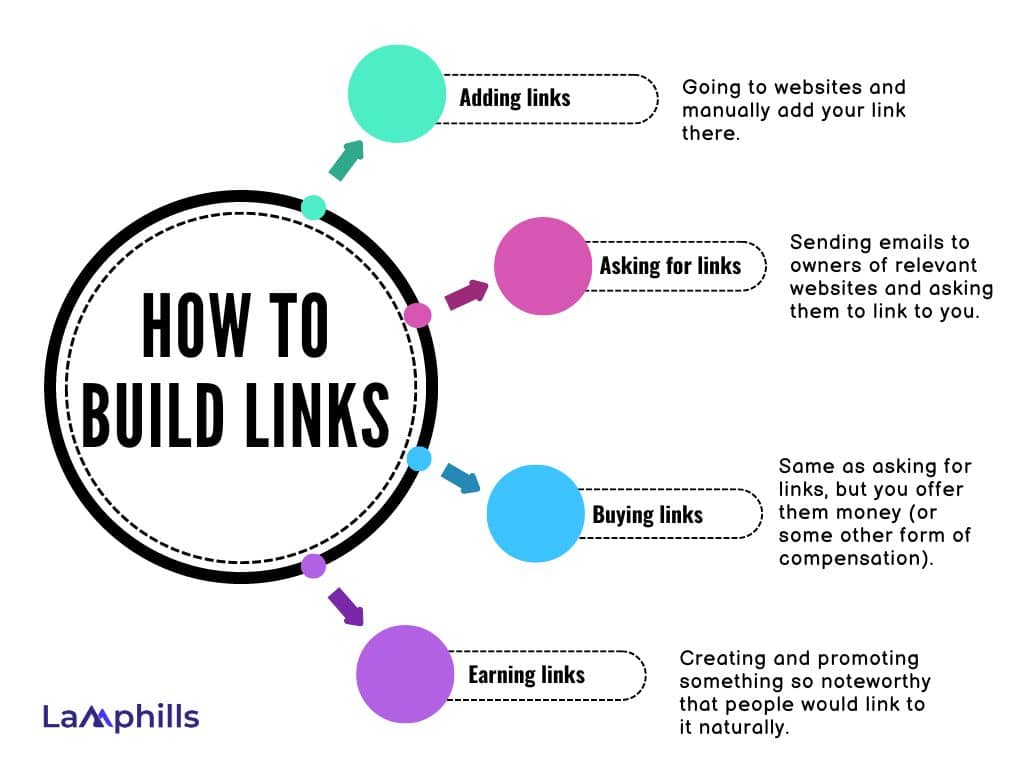
#1. Adding links
This is when you go to a website that doesn’t belong to you and manually place your link there.
The most common tactics that fit into this category are:
- Social profiles creation.
- Business directory submissions.
- Review site listings.
- Posting to forums, communities, and Q&A sites.
Building links via those tactics is very easy to do. For that exact reason, though, such links tend to have little to no value in the eyes of Google. Other than that, these kinds of links barely give you any competitive edge. If you can go to a website and manually place your link there, so can your competitors.
And yet, this group of link-building tactics should not be ignored completely. In fact, some professional link builders prefer to start with these kinds of links when they’re working with a brand-new website.
They refer to it as building “foundational links.”
#2. Asking for links
This is when you reach out to other website owners and ask them for a link, which SEOs often refer to as “link outreach.”
You need to pick websites that are somehow related to your page, since they are more likely to actually consider your request. The process of collating a list of relevant websites to reach out to is called “link prospecting.” And the more effort you invest into finding suitable outreach targets, the higher your success rate would be.
But why would owners of other websites (even the relevant ones) care to link to your page? Well, ideally, you want them to be so impressed with your resource that they would naturally want to share it with the visitors of their website (i.e., link to it).
#3. Buying links
This is the easiest way to build links. A lot of website owners would be happy to link to you if you pay them for it.
However, exchanging money (or anything else, really) for links is quite risky. Google considers it a manipulation of its algorithm. And it might punish you for it by kicking your website out of the search results.
Another risk of buying links comes from simply wasting your money on bad links that won’t even work in the first place.
Yet, many people in the SEO industry do buy links to achieve their ranking goals. Once you start researching your competitors’ backlinks and reaching out to the same websites, you’ll soon find out if they paid for any of their links.
#4. Earning links
You “earn” links when other people link to the pages on your website without you having to ask them to do so. This won’t happen unless you have something truly noteworthy that other website owners will genuinely want to mention on their websites.
So here are a few things that can make the pages of your website worthy of a link:
- Your company’s proprietary data
- Results of experiments (which require significant efforts)
- Unique ideas and strong opinions (i.e., thought leadership)
- Industry surveys
- Breaking news
Best Link-Building Strategies
There are many different link-building tactics and strategies out there. Some of them can be very effective, while others no longer work these days and will most likely just waste your time.
Here’s what works really well today, according to our observations:
Best Link-Building Strategies
10 Best Link-Building Tools For You
#1. Google
Most people don’t think of Google as a link-building tool, but it’s one of the best ways to find link prospects. That’s because it has the largest index of web pages on the planet and arguably the best search algorithm. So if you know how to use it effectively, you can easily find thousands of relevant link prospects for free.
Search operators are commands that help you refine and filter search engine results. Some are unique to Google, but not all of them (as you can use the same or similar ones in Bing or Ahref’s Content Explorer). But even the ones that aren’t totally unique to Google seem especially powerful there because you can combine them to pull exactly what you need from its insanely vast index.
For example, you can combine the intitle:, inurl:, and OR operators to find relevant resource pages to pitch your link:
[keyword] (intitle:resources OR intitle:resource) (inurl:resources OR inurl:resource)
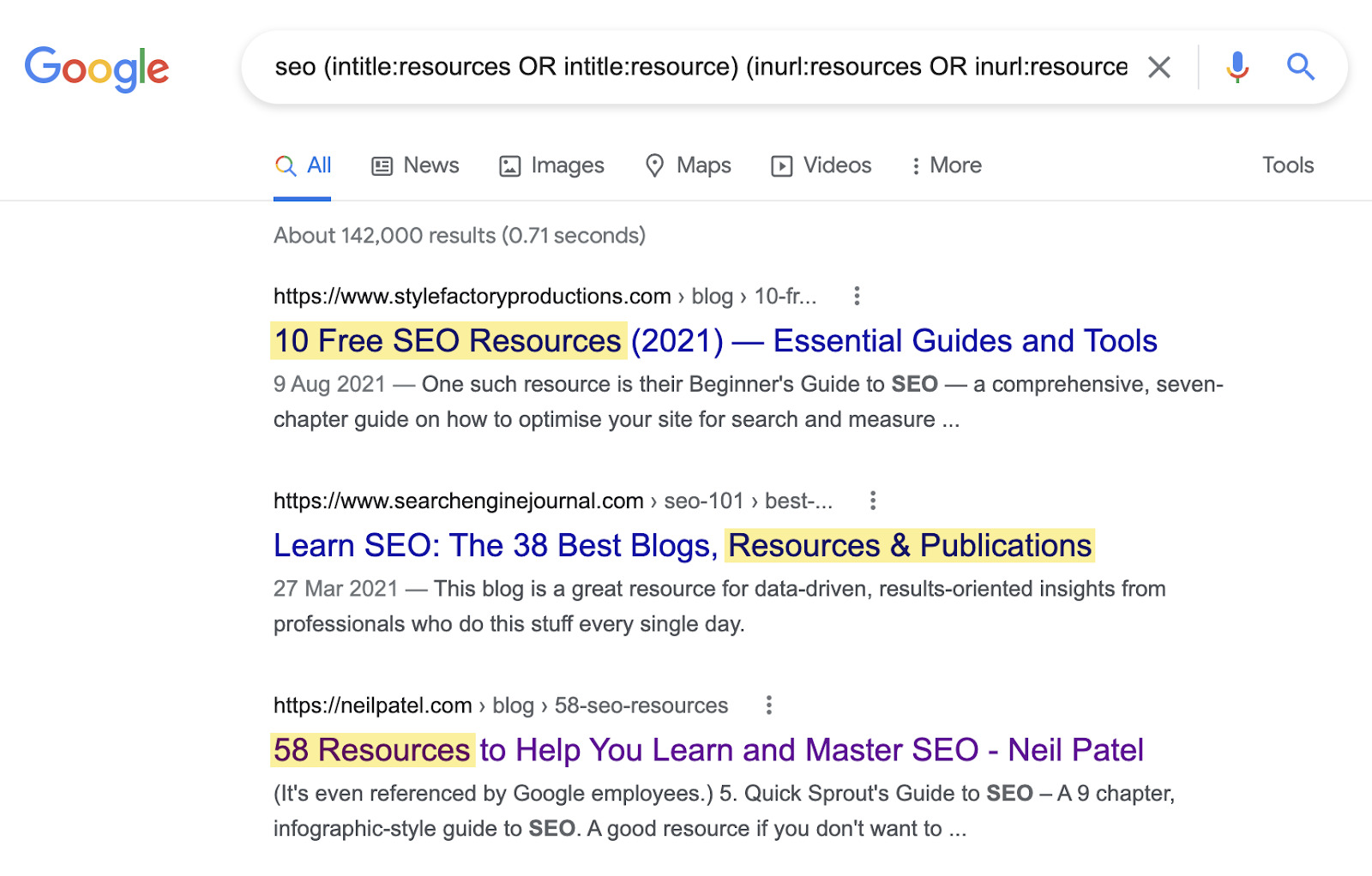
The only downside of using Google for link prospecting is that there isn’t any way to download the results. You can solve this with a Chrome add-on like Ahrefs’ SEO Toolbar, which has a button to download SERP data.
#2. SemRush
As a top-rated SEO platform, Semrush is home to some of the best backlink tools that help businesses like yours create robust link-building strategies. These tools include backlink sources, outreach modules, and detailed monitoring to ensure links are still active after you’ve added them to your backlink profile.
Semrush is also a top tool because of its extensive list of SEO tools beyond link building. Plus, the Semrush pricing plan offers additional add-ons so you can pay for only what you need.
From performance dashboards to competitive research tools, Semrush has it all. Check out some of Semrush’s other SEO tools below:
- On-page and technical SEO auditing
- SEO content templates, including an artificial intelligence (AI) assistant for better keyword integration and filling content gaps
- Local SEO position tracking and listing management tools
#3. Ahrefs
Ahrefs is one of the best link-building tools to try if you’re looking for something that offers up hard data along with its insights. It provides comprehensive link-building capabilities, including dashboards detailing your website’s backlink profile and growth over time.
Want more? Ahrefs’ backlink dashboard also allows you to analyze sites your competitors link to and their quality.
Link Semrush, Ahrefs isn’t primarily a link-building tool — it’s home to dozens of additional SEO tools to help businesses build a solid SEO strategy, including:
- An extensive keyword database
- Detailed website analytics through Ahrefs’ SEO auditing software
- Scheduled reports that monitor your website’s rankings on search engines
#4. Hunter
Hunter is an all-in-one email outreach platform you can use to set up and manage your link-building outreach campaigns. Its core products include:
- Email Finder: Helps you find the email address of any prospect. All you need to do is enter their name and website domain.
- Email Verifier: Prevents email bounces by checking whether the email addresses on your list are valid.
- Domain Search: Reveals the email addresses associated with any website. This can be helpful if you’re unsure who you should contact at a target website.
- Campaigns: Handles cold email outreach with automated follow-ups, personalization, custom sending schedules, and more.
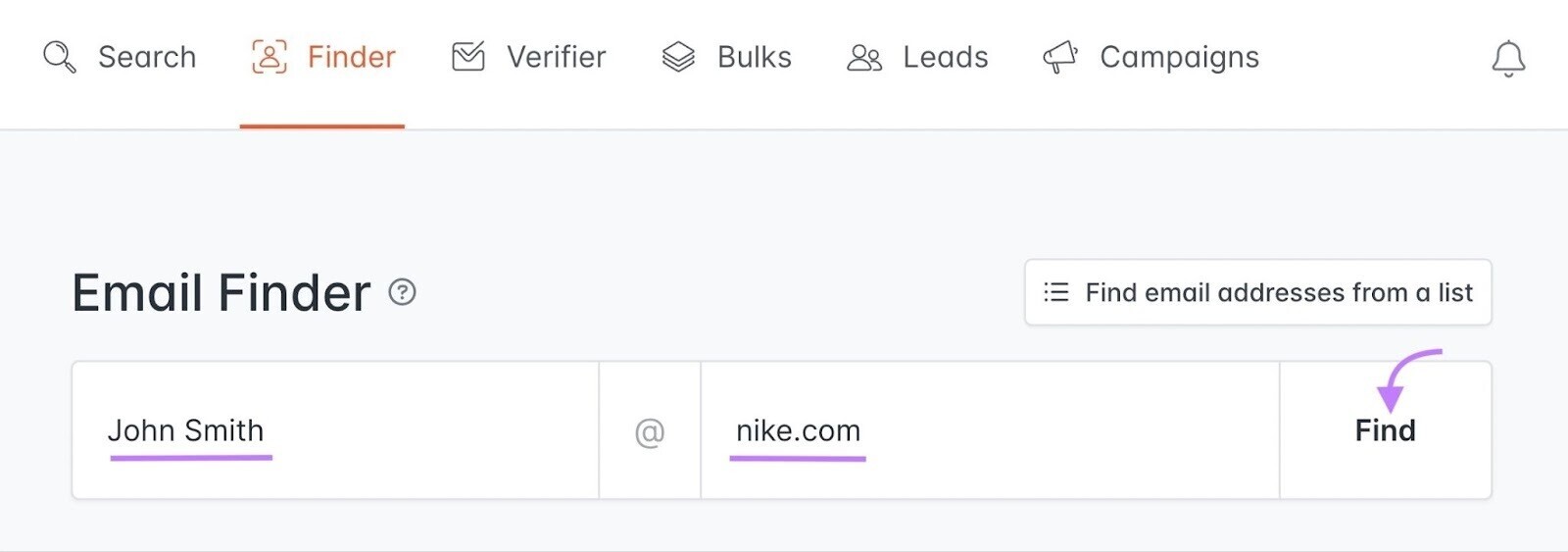
Hunter also offers a Chrome extension you can use to find email addresses behind the websites you’re browsing. Also, there’s a Google Sheets add-on that can be quite handy if you typically build prospect lists in Google Sheets.
#5. Check My Links
Check My Links is a free Google Chrome extension that crawls through any web page to check for broken links. It’s one of the fastest link checkers you can use, and it registers and reports all of the broken links on a website within 20 to 30 seconds.
This gives you a significant advantage when contacting websites to promote links.
After checking a site with Check My Links, you can compile the broken links that are most relevant to your subject matter and propose replacing them with your functional links. Hopefully, the site’s owner will appreciate you pointing out the broken links and offering a solution and will update the post with your replacement links ASAP.
#6. Mentioned – Outreach Wizard
Mentioned – Outreach Wizard is another one of the best link-building tools to use, as it facilitates the process by scanning your existing content to identify outreach prospects that are already mentioned on your site.
Once identified, this tool automatically sources their contact information and provides email templates for various outreach purposes. Thesee include linking from another post, sharing on social media, building partnerships, and more.
To get started, simply enter your blog’s URL into the search bar and click “Scan,” and the app will source contact information and draft emails within seconds.
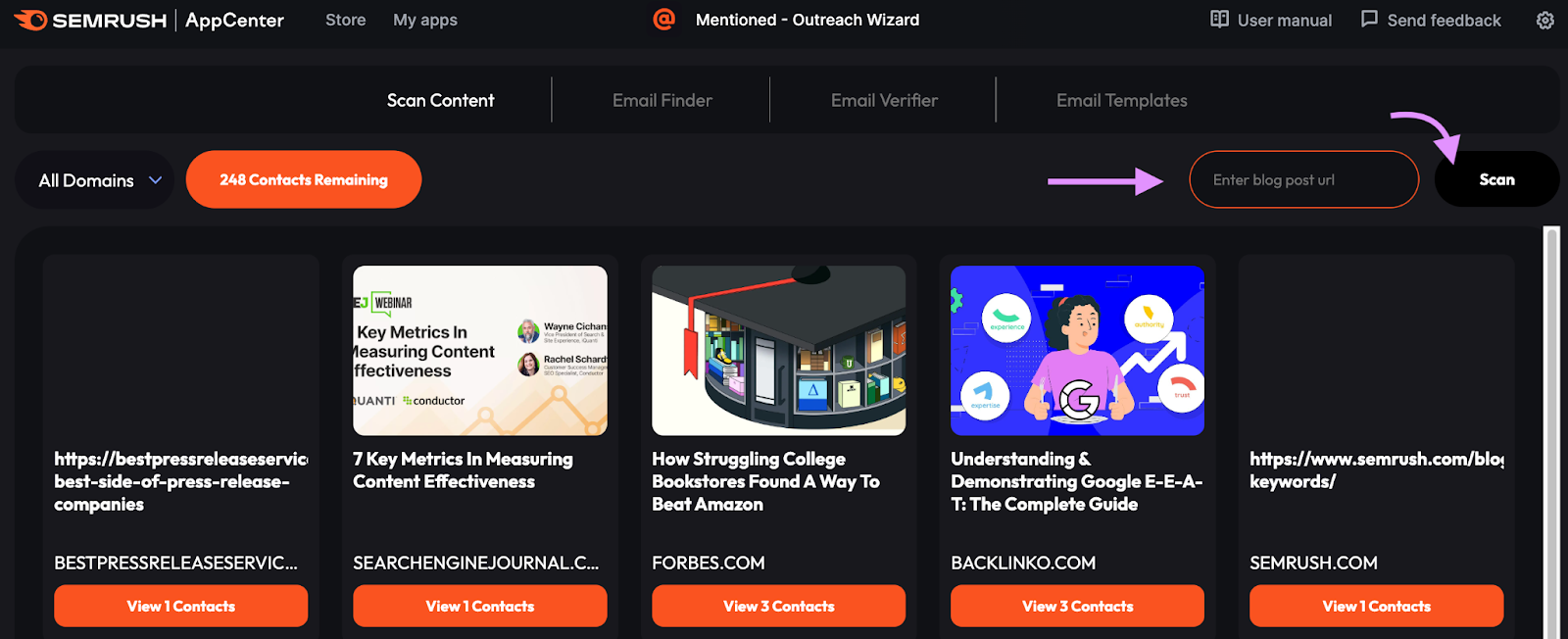
You can also locate and verify recipient email addresses to ensure you’re not wasting any effort.
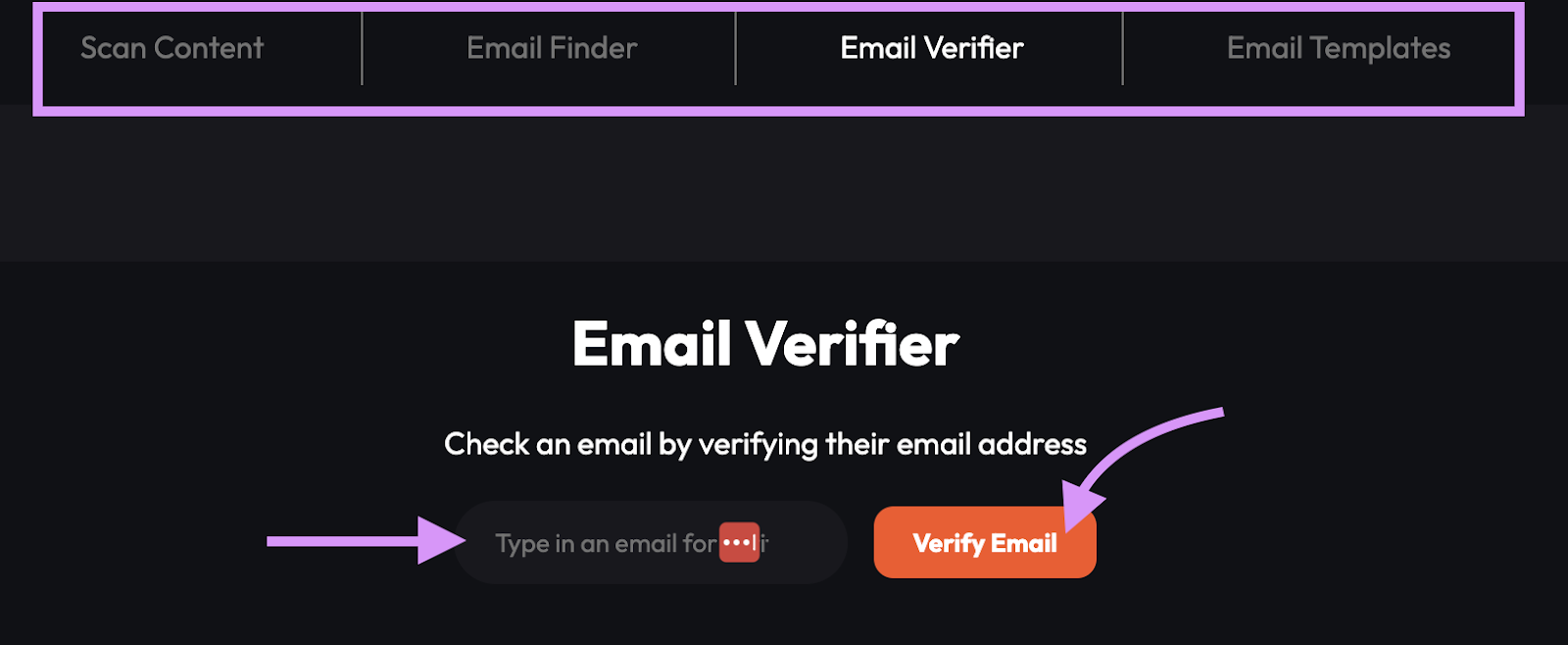
Finally, you can choose an email template to quickly reach out to the desired contacts.
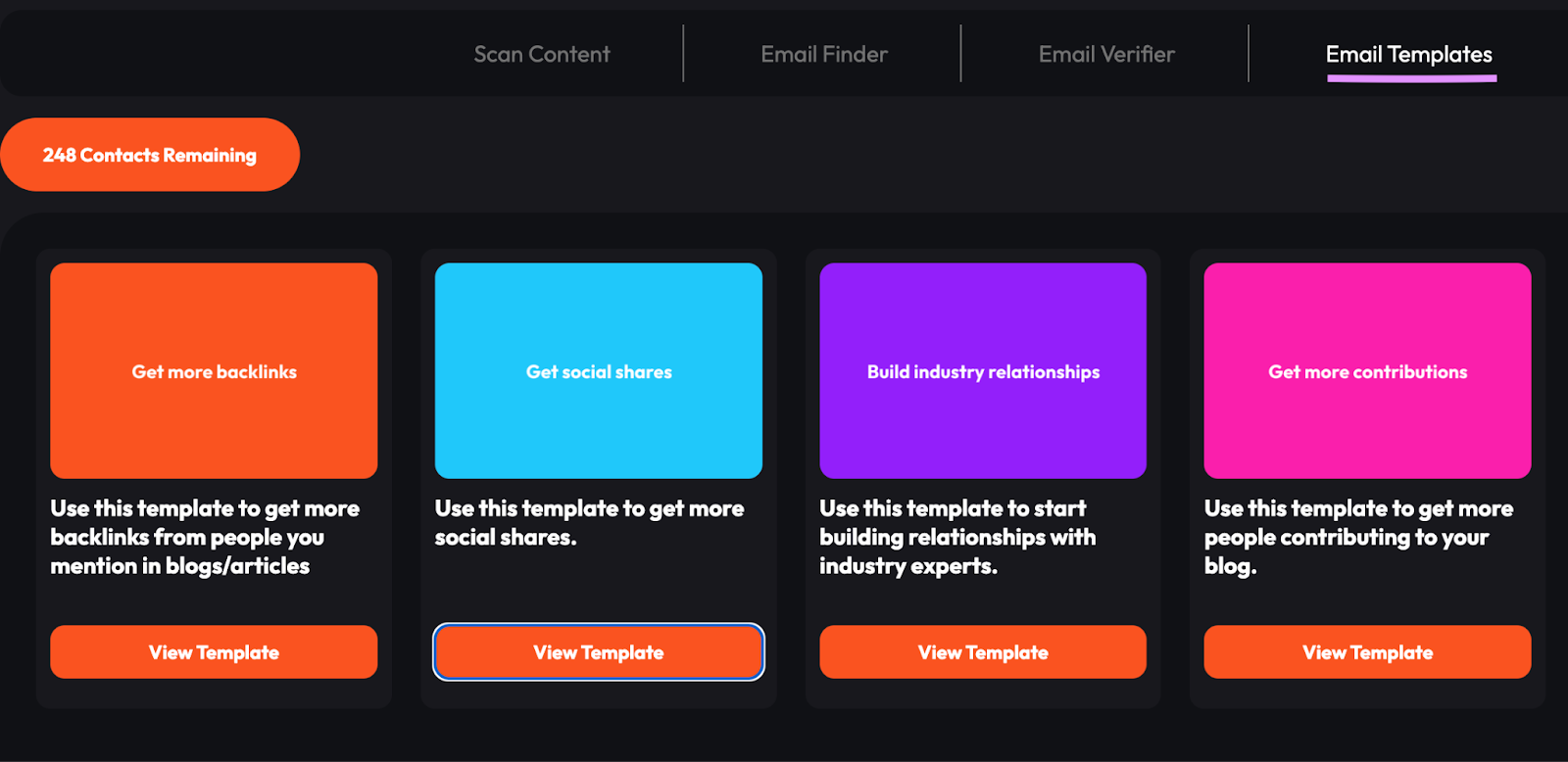
#7. Buzzstream
Gmail is great if you’re only planning to send a few outreach emails, but you need a dedicated tool to scale your email outreach. That’s where Buzzstream comes in. It lets you manage, organize, personalize, track, and send emails all in one place. You can also add multiple users to your account and assign tasks between them.
BuzzStream’s outreach platform is designed for PR teams that are looking to automate and scale their outreach efforts. You can use it to identify link-building prospects and find their contact details. It can even build a list of prospects for you. All you need to do is input a list of search queries. BuzzStream will then find relevant websites and identify the right people to contact at each website.
It seamlessly imports Ahrefs CSV exports too:
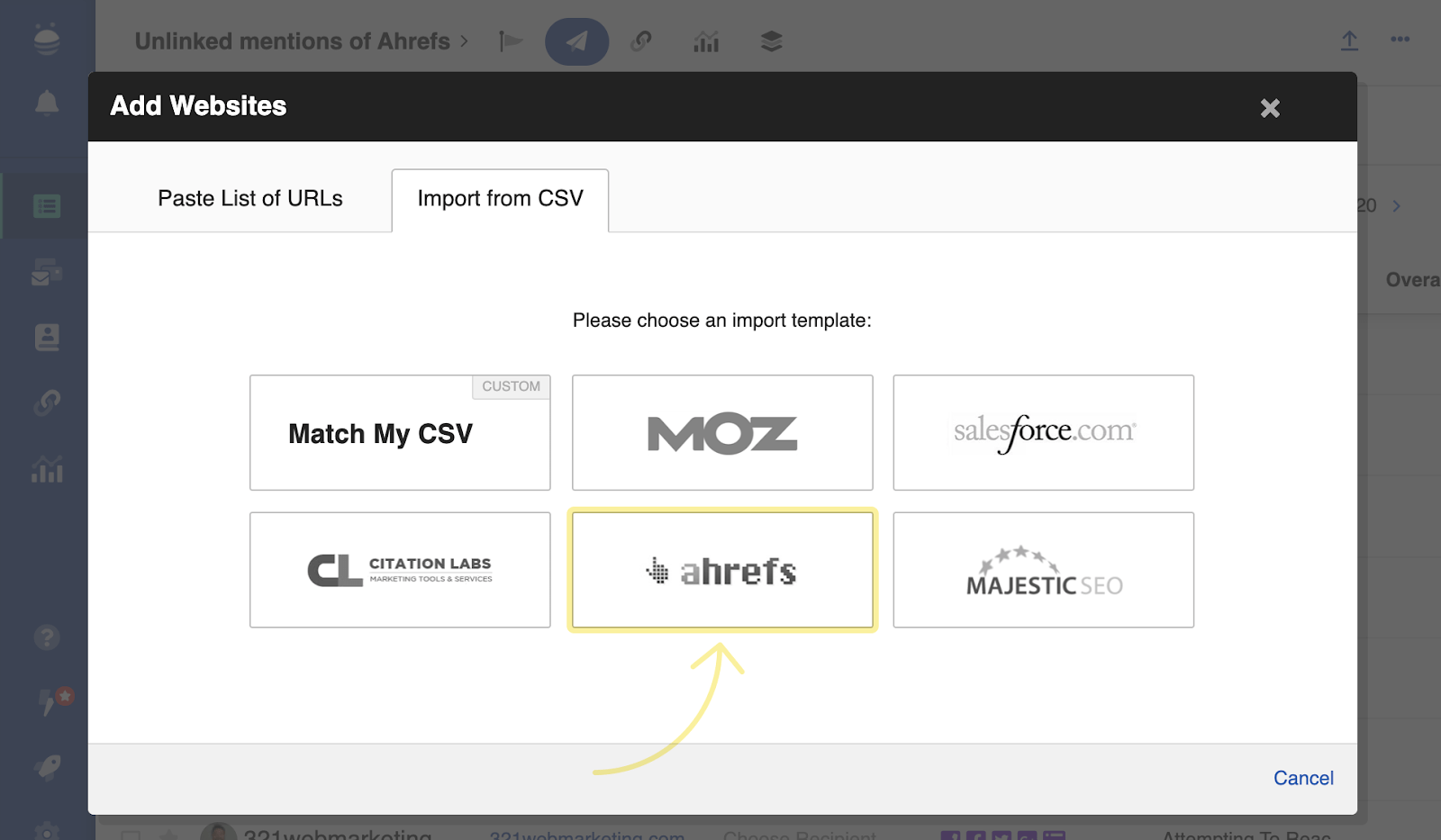
Buzzmarker is a Chrome extension that helps speed up link prospecting. You can use it to find contact information, add prospects to campaigns, and even compose emails from templates as you browse the web.
#8. BuzzSumo
BuzzSumo is a brand monitoring and content discovery tool that includes a number of handy features for link builders.
First, you can use it to uncover and track domains that link to your competitors.
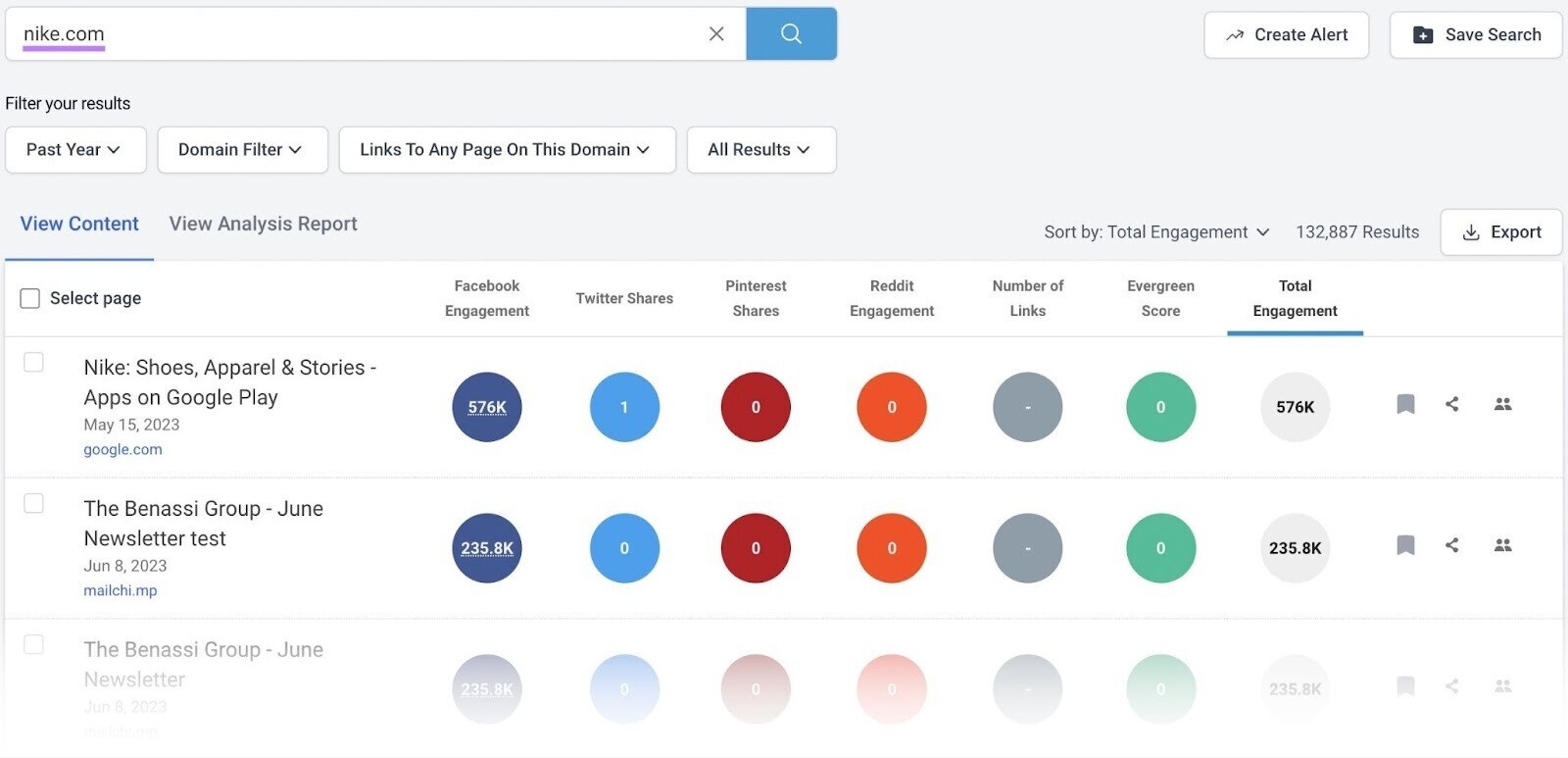
BuzzSumo lets you export these domains to a spreadsheet to use in your own link-building outreach campaigns. There’s also the option to set up alerts to notify you as soon as a website links to one of your competitors.
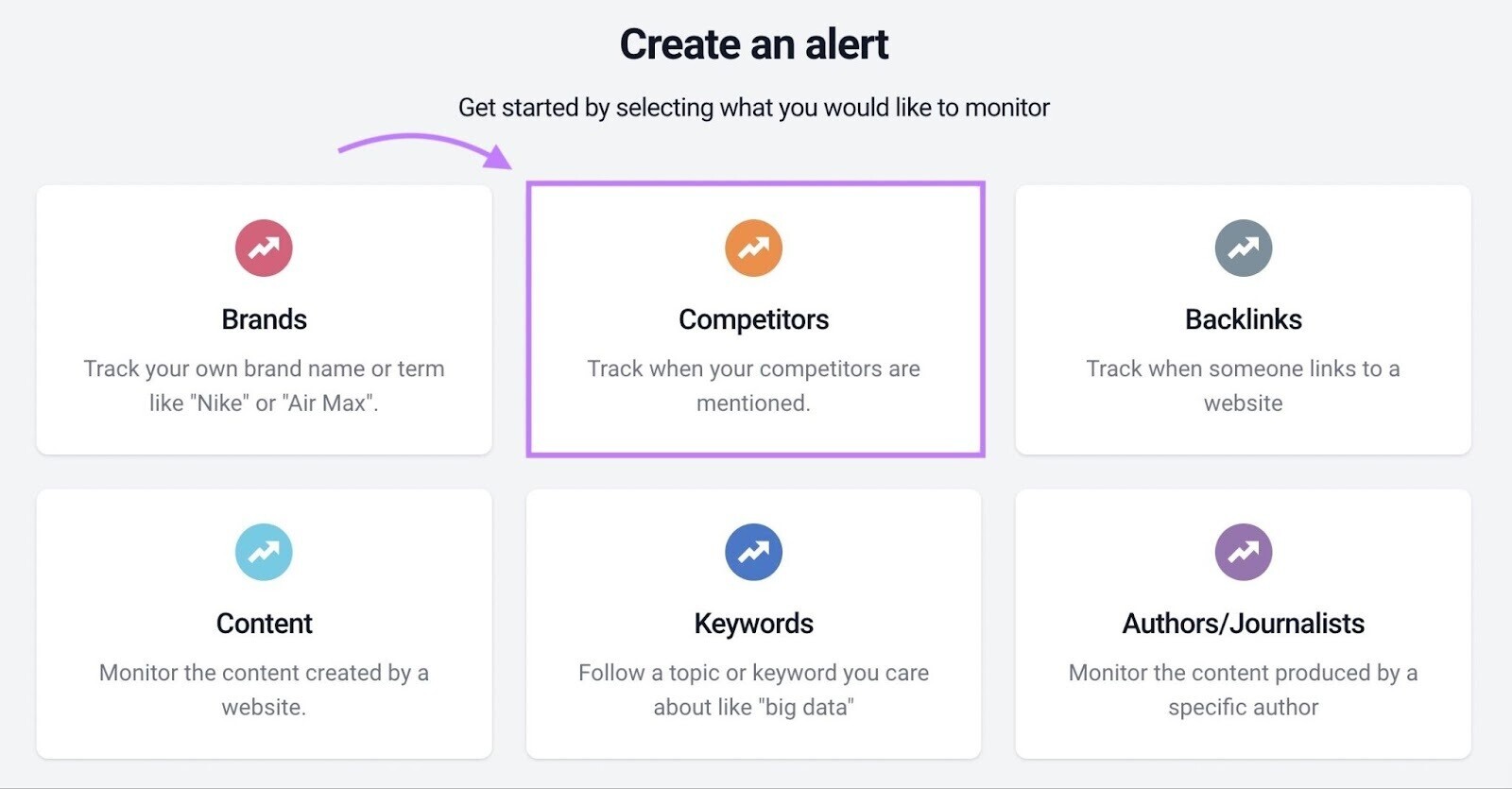
Finally, you can use BuzzSumo to track your own backlinks and get alerted when you get a new backlink.
BuzzSumo allows you to uncover backlink opportunities by creating alerts for your competitors’ writers and content marketers. You get notified every time they’re listed as an author on a guest post. This will help you find guest posting (and link-building) opportunities for your own website more easily.
#9. Help a Reporter Out
Help a Reporter Out (HARO) isn’t a traditional link-building software. It’s a platform that connects journalists with sources who can share their expertise on a particular topic. However, it’s often used by sources who want to secure backlinks in various publications.
Both big and small media outlets use the platform. Some of the most popular ones are The New York Times, Fox News, and Mashable.
Sources receive three HARO emails every day, Monday to Friday. Each email contains a list of requests from journalists looking for sources who can share insights for an article.
Like this:
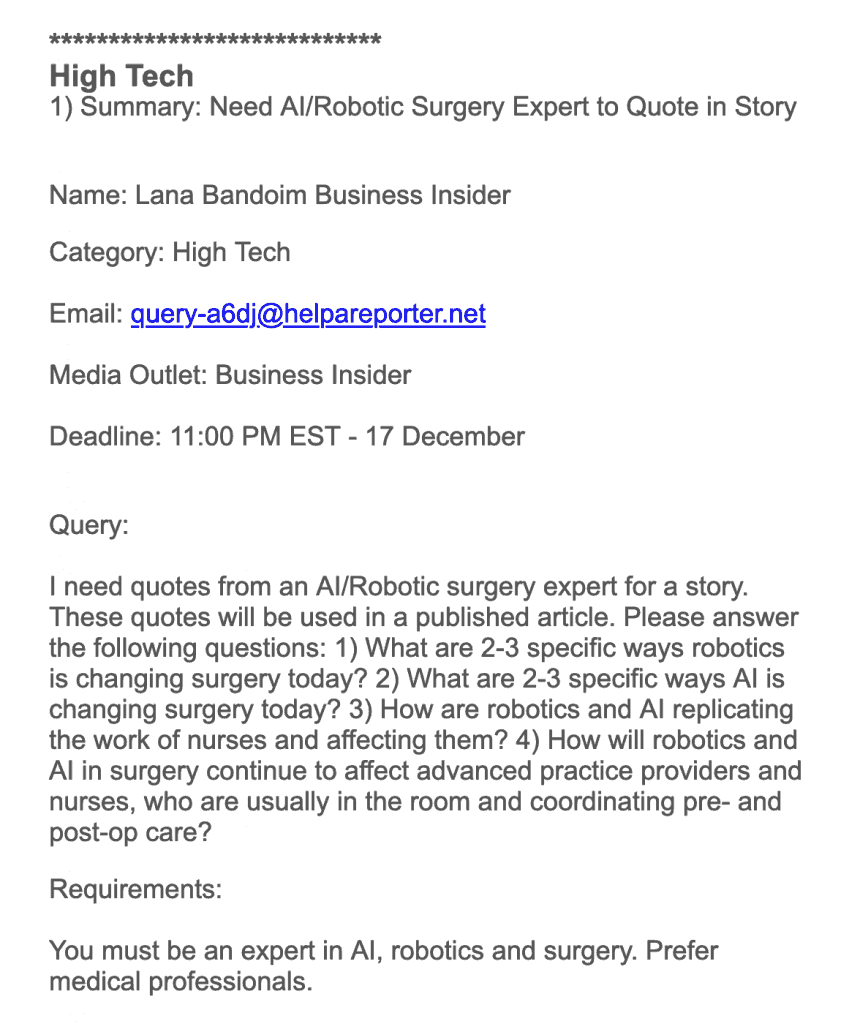
All you need to do to respond to a source request is send a reply (called a pitch) to the provided email address. If a journalist decides to use your response, they’ll include it in their article as a quote (or quotes). And they’ll typically include a link to your website.
The large number of daily source requests means you’re likely to find backlink opportunities every day—all you need to do is consistently send replies.
#10. Serpstat
Topping off this list of the best link-building tools to use in 2024 is Serpstat, an all-in-one SEO tool that helps with many other SEO tasks besides building links.
Serpstat comes with a valuable backlink checker that produces your site’s detailed link profile analysis. You can learn everything about your website’s backlink profile, including:
- The quantity and quality of your site’s backlinks
- Low-quality backlinks that may affect your site’s rankings
- Anchor texts from links that refer to your site
- Domain comparisons that help you find trusted link donors
Along with backlink tools, Serpstat offers SEO tools like:
- Content generation tools, including AI assistants
- Keyword research and clustering
- On-page and technical SEO auditing
Recommended Articles
- How to Pitch a News Story to an Editor (Expert Guide)
- How You Can Secure High-Quality Relevant Links to Improve Your SEO Rankings
- How to Turn Unlinked Mentions into Backlinks: Practical Tips from My Experience
- What Link Insertion Is and 5 Steps to Use Them Effectively
- Link Building Outreach: Beginners Guide (+Templates)





